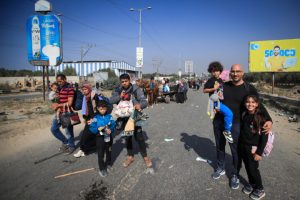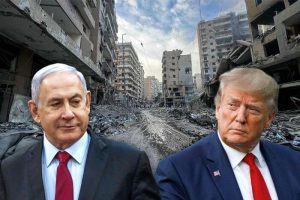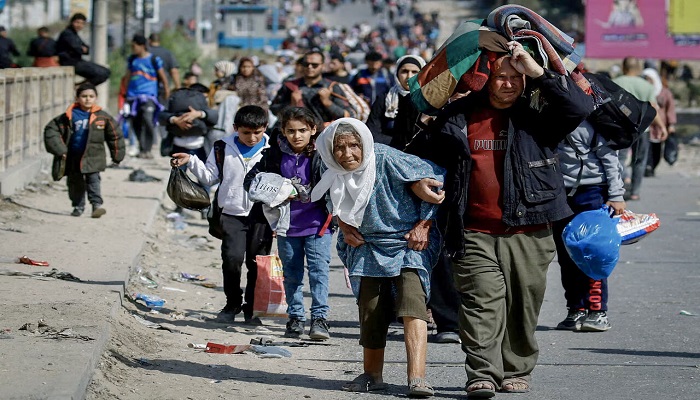PNN – In recent months, the Zionist regime has been trying, in a specific process, with its destructive and targeted attacks to achieve the plan of forced migration of Gaza residents and ethnic cleansing.
According to the report of Pakistan News Network, in recent months, the issue of ethnic cleansing in Gaza has become one of the most controversial and sensitive topics on the global level. The Israeli regime’s actions, including a long-term economic and military blockade, frequent air and ground attacks, widespread destruction of homes, schools, and hospitals, and severe restrictions on access to basic resources such as water, food, and medicine, have made living conditions extremely inhumane for the more than two million Palestinians living in the Strip.
These policies, which some see as a deliberate attempt to forcibly relocate and gradually eliminate the Palestinian population, are rooted in the historical, political, and ideological complexities of the disputed issue of Palestine, which themselves require a separate and detailed discussion.
Read more:
The Zionist regime has demonstrated its determination to cleanse Gaza of its Palestinian population since the start of the war in October 2023. The Zionists have a considerable expertise and history in this field; since the beginning of their entry into and occupation of the Palestinian territories, the Zionists have been trying to ethnically cleanse the West Bank, and they continue this effort with greater intensity.

The concept of a Greater Israel represents the fundamental goal of Zionism and its political elite. For decades, the Zionist regime has sought the mass transfer of the Arab population from historic Palestine. For the regime’s current leadership, as well as large segments of Israeli society, the war on Gaza has presented a fundamental opportunity: an opportunity to expel the Palestinians from Gaza once and for all.
By examining the policies of the Zionist regime in Gaza, experts and analysts divide the Zionist strategy for the destruction and ethnic cleansing of Gaza into the following stages:
Eliminating media coverage of what is happening in Gaza, reducing the population in Gaza, completely destroying and destroying the healthcare system, making Gaza uninhabitable, diplomatic legitimacy for ethnic cleansing in Gaza.
The Zionist regime and the elimination of media coverage of what is happening in Gaza
In terms of suppressing independent media coverage, limiting independent media coverage of events in Gaza, and controlling global narratives about the conflict, Israel is accused of restricting the flow of information from Gaza by using methods such as barring international journalists, cutting off internet and telecommunications connections, and directly targeting Palestinian journalists.
The Committee to Protect Journalists (CPJ) has reported that more than 90 percent of the world’s media victims have been Palestinian since October 2023, reflecting a focus on attacks on Gaza’s war correspondents. The killings come as Israel, with support from the West, particularly the United States, continues its offensive.
The silence of mainstream media and Western governments over these crimes has drawn widespread criticism. A 2024 CPJ report blamed Israel for “the most targeted killings of journalists without investigation” and described the war as the bloodiest period for the media since 1992. Journalists in Gaza have continued to tell the truth, despite power cuts, internet blackouts, and constant threats, but they have paid the price with their lives. This tragedy is not only a violation of international law, but also a warning to the world that the suppression of truth is an integral part of this war.
Evidence suggests that censorship of pro-Palestinian content on social media platforms, often under pressure from governments or pro-Israeli lobbies, is also part of this strategy. The aim, critics say, is to reduce international pressure by preventing the publication of images and reports that could spark global outrage.
Declining Palestinian population living in Gaza
This phase of the Israeli regime’s policies towards ethnic cleansing of Gaza refers to actions that result in a reduction in the number of residents of the area through killing, forced displacement, or creating unbearable living conditions. According to the latest reports from the Palestinian Ministry of Health, the total number of martyrs in the Zionist regime’s genocidal war from October 7, 2023 to today is 51,305, and the number of people injured in the Zionist attacks on Gaza has reached 117,096.
Frequent evacuation orders, especially for northern Gaza, coupled with widespread bombardment of residential areas as well as the blockade of some areas in Gaza such as Rafah, have led to mass displacements southward, especially to areas such as Rafah and Khan Yunis.

Also, the Zionist regime’s actions to prevent the entry of first aid, food, and electricity cuts and the destruction of Gaza’s water resources are among the actions of the Zionist regime aimed at forcing the people of Gaza to relocate and ultimately ethnic cleansing in Gaza.
Some analysts, such as Amnesty International’s December 2023 report, describe these measures as an attempt to “forcefully transfer” or permanently remove Palestinians from parts of Gaza. Statements by Israeli officials, such as the proposal for “voluntary migration” of Palestinians out of Gaza or the “generals'” plan to evacuate northern Gaza, have been presented as evidence of the regime’s true intentions.
Destruction of the treatment system and creation of a health crisis
The destruction of Gaza’s health infrastructure has been proposed as part of a strategy to undermine the region’s ability to sustain its population.
According to the World Health Organization (WHO) and Doctors without Borders, more than 560 attacks on health facilities in Gaza have been recorded since October 2023. These attacks have included the bombing of hospitals such as Al-Shifa, Nasser, and Kamal Adwan, and the destruction of local clinics. More than a thousand doctors, nurses, and medical staff have been martyred or arrested, and a large part of Gaza’s hospitals have been completely destroyed.

Shortages of medicine, medical equipment, and fuel for generators, combined with the siege, have made it impossible to provide basic care. There have also been reports of patients dying due to lack of access to dialysis, chemotherapy, or emergency surgery. Doctors without Borders has described the attacks as “deliberate” and aimed at increasing civilian suffering.
Turning Gaza into a dead land
This phase focuses on the widespread destruction of critical infrastructure and the creation of environmental conditions that make life in Gaza virtually impossible. UN reports indicate that by early 2025, more than 90 percent of Gaza’s housing units will have been destroyed or severely damaged, water and sewage systems will have collapsed, and more than 80 percent of agricultural land will have been destroyed. The extensive bombing, which some sources have estimated to be equivalent in intensity to two multi-nuclear explosive devices, has led to environmental contamination, including contamination of groundwater and soil.
In fact, the ongoing war in Gaza has caused severe environmental damage to the region, affecting the air, water, and land and all those who depend on them. The effects of heavy metal pollution have also been documented as a result of the intense Israeli bombardment of Gaza. The air is contaminated with chemicals from weapons such as white phosphorus due to the widespread use of explosives, and exposure to white phosphorus munitions in turn leads to reduced productivity of agricultural land, which can damage existing plants.
The published carbon emissions figures are also staggering. The war produced an estimated 536,410 tons of carbon dioxide in the first 120 days, 90 percent of which was due to Israeli air and ground attacks on Gaza. This is more than the total annual carbon emissions of many countries at risk of climate change.
Creating political and diplomatic legitimacy for the ethnic cleansing plan
This refers to an attempt to justify the actions of the Zionist regime at the international level and to reduce diplomatic and legal pressure. The Zionist regime, relying on the strong support of Western allies, especially the United States, and using narratives such as the “fight against terrorism” or the “right to self-defense”, is trying to legitimize its operations in Gaza.
The United States’ veto of ceasefire resolutions in the UN Security Council, its continued multi-billion dollar military aid to the Israeli regime, and its rejection of diplomatic proposals to stop the fighting are seen as part of this strategy.

Pressure on international organizations such as UNRWA and suppression of global criticism, including labeling critics of the regime as “anti-Semitic,” have been cited as ways to maintain this diplomatic legitimacy.

